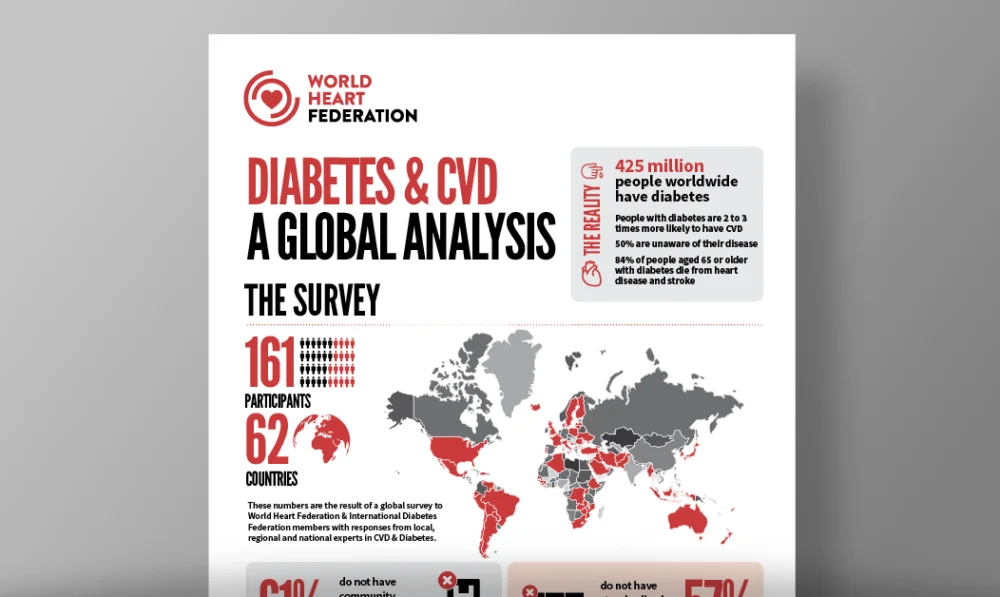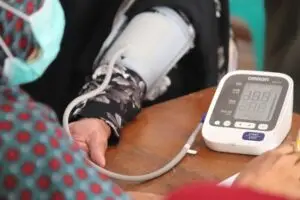Return to CVD Roadmaps Home
Type 2 diabetes mellitus is a major global health threat. It affects 425 million people with the overall figure predicted to rise to 629 million by 2045, and accounts for approximately 90% of all patients with diabetes. All of those living with diabetes are at heightened risk of CVD making the prevention of CVD onset a major priority.
The Roadmap on the prevention of cardiovascular disease among people living with diabetes, developed by WHF in partnership with the International Diabetes Federation, is a key reference document for anyone involved in the planning, organisation, implementation and monitoring & evaluation of approaches related to CVD prevention in people living with diabetes. It outlines a vision of an ideal pathway of care, potential roadblocks along this pathway, and proposed solutions, with examples from practice.
About CVD and Type 2 Diabetes Mellitus
Diabetes is a metabolic disorder characterized by high blood sugar, insulin resistance and relative lack of insulin. Long-term complications from high blood sugar include heart disease, strokes and diabetic retinopathy, which can result in blindness, kidney failure and poor blood flow in the limbs that may lead to amputations. Pathophysiologically, diabetes is a vascular disease. Those living with type 2 diabetes mellitus are twice as likely to die from heart disease and stroke compared to patients without diabetes. It is estimated that globally, as many as 212.4 million people or half of all people aged 20-79 years with diabetes are unaware of their disease, and these people are all at increased risk of CVD. All of this results in an urgent need to prevent CVD in those with diabetes, requiring careful attention to CVD risk factors such as tobacco use, hypertension, obesity, unhealthy diets, cholesterol, air pollution, and blood lipids.
The magnitude of the problem
In 2015, the global economic burden of type 2 diabetes mellitus was estimated to be $1.3 trillion, or 1.8% of the global GDP; and it is estimated that this burden will increase to $2.1 – $2.5 trillion by 2030. Twelve percent of global health expenditure is spent on diabetes ($727 billion). Despite the high prevalence and burden of diabetes worldwide, diagnosis and treatment continues to fall behind required levels.
The Roadmap on the prevention on CVD in people with diabetes was officially launched at ESC Congress 2019 together with the World Congress of Cardiology on Monday 2 September 2019.
Patient story
“Twenty years ago I was diagnosed with type 2 diabetes and was told that I would have to follow precautions and carefully look after my health. I was a happily married retired bookmaker, with three children and five grandchildren. Other than having diabetes I felt fit, happy and healthy.
After picking up a leaflet in my doctor’s surgery, I decided to have my heart checked. My test revealed a possible problem and I was sent for an angiogram, which showed five blockages – three in the main arteries to the heart and two minor blockages. I was told the problem was serious and that I needed surgery.
Just a few months later, I was recovering from a triple bypass surgery. I am grateful that my problem was picked up before I had symptoms and it became life threatening.
I hope my story will encourage people to monitor their heart health to avoid potentially serious problems, especially for people with diabetes as they often fall into a higher risk category for developing heart disease. I was not aware of this increased risk until I was diagnosed with heart disease one year ago.”















